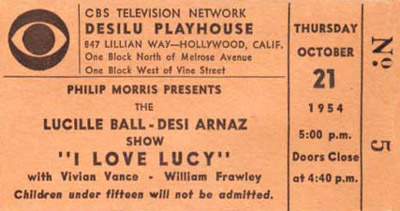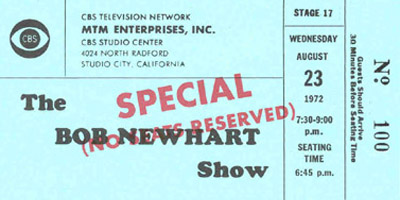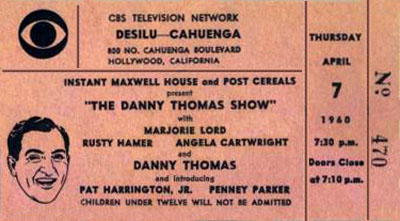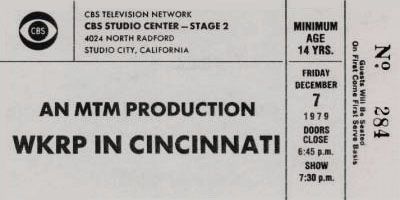I Love Lucy

For several years on radio, Lucille Ball had a successful series called My Favorite Husband, in which Richard Denning played her hubby, a banker. In 1951, a lot of radio shows were being converted to TV programs and My Favorite Husband, because of Ms. Ball’s flair for physical comedy, seemed like a natural. But when the subject was raised with Lucy, she startled everyone by insisting that her real husband, Desi Arnaz, play her spouse in the TV show. This was because she felt it might save a troubled marriage if the two of them were together more often…and it did, but only for a while.
But there was another bonus for the Arnaz couple. Desi couldn’t play a banker. He could barely play what he was…a Cuban bandleader. So bringing in Desi meant abandoning the My Favorite Husband format and creating something new. Which meant that Lucy and Desi could own the new show…which they did, starting a TV empire called Desilu. And so they became Lucy and Ricky Ricardo…and very wealthy.
There are many books out about I Love Lucy, the most often-rerun show in television history. They tell of how Desi (or more likely and accurately, his producers) invented the “three-camera” technique for filming a sitcom like a play; of how Desi became work-obsessive running the studio and that eventually harmed their marriage; of how William Frawley and Vivian Vance were so perfect as the landlords, Fred and Ethel Mertz, but hated each other. You can read all that stuff elsewhere.
The above ticket is for a filming on October 21, 1954. This was for an episode called “Getting Ready,” which was about preparations for the Ricardos and the Mertzes to go to Hollywood so Ricky could make his motion picture debut. The finished episode aired on December 13.
The first episode of I Love Lucy aired on October 15, 1951 and the last one aired on May 6, 1957. These were followed by many Lucy-Desi hour long specials, and of course Lucy went on to star in three other series: The Lucy Show, Here’s Lucy and Life With Lucy.
Bob Newhart Show, The (1972-1978)



The monologues of acclaimed stand-up comic Bob Newhart usually involved him playing straight man to an unheard voice on an imaginary telephone. He’d be the perfectly sane, calm guy trying to make sense out of what someone was telling him. That’s why it was a brilliant idea on the part of series creators Lorenzo Music and David Davis to make him a psychologist in a situation comedy, surrounded him with eccentric characters. The joke, of course, was that Dr. Robert Hartley (his role) had just as much trouble managing his life as his patients did handling theirs. In fact, Dr. Hartley often had to seek advice from his wife Emily (played by Suzanne Pleshette) or an orthodontist friend (played by Peter Bonerz).
The Bob Newhart Show wasn’t Newhart’s first series. He’d previously starred in two variety shows — The Bob Newhart Show (1961) and The Entertainers (1964), neither of which succeeded, though the first did have the dubious honor of winning an Emmy after its cancellation. Both were quickly forgotten, not only by the public but by Newhart, who later spoke of his 1972 series as if it was his first series. (In his 2006 autobiography, I Shouldn’t Even Be Doing This, he mentioned The Entertainers in passing and didn’t mention the first series at all.)
This was understandable since the ’72 show was a monster hit, and not just because of its great time slot. It followed The Mary Tyler Moore Show (from the same production company) on Saturday nights but quickly developed its own loyal following. It fared particularly well in reruns, attesting to its strength.
The series was on for six years. Newhart has explained that he wanted to end it after Year Five but was politely informed by CBS that if he walked out on his contract, they would sue him for their expected profit for Year Six. As this amount was tens of millions of dollars, Bob decided that a sixth season wasn’t such as bad idea, after all.
All in the Family



One of television’s most ground-breaking TV shows, All in the Family, debuted on CBS on January 12, 1971…so folks who used the top ticket above to attend a taping had no idea what to expect. The show had been developed for ABC and its pilot was taped twice, both times with Carroll O’Connor and Jean Stapleton in the leads, though with other actors playing the kids each time. When CBS bought the third version of the pilot, the network was in a transition period, dumping shows that skewed older and/or to rural audiences. They were trying to reposition the network for younger, more urban viewers and Norman Lear’s new series was a daring step in that direction.
The show was not an immediate hit. When its early airings were noticed at all, it was to discuss the coarse, bigoted language employed by its central character, Archie Bunker. But CBS stuck with it and audiences discovered it about the time the first thirteen episodes were in rerun. When it was moved from Tuesday nights at 9:30 to Saturday nights at 8:00, it became not only a smash hit but the leader of a new wave of television comedy.
I attended a taping of All in the Family in 1972. What I recall most about the evening was that the warm-up, done by Norman Lear himself, was very long and he kept (a) plucking ladies out of the audience and dancing the tango with them in the aisles, and (b) urging us to watch his new series, Maude. The episode itself had Vincent Gardenia and Rue McClanahan playing a couple that had placed an ad for wife-swapping, and Edith Bunker innocently answered it. Soon after, Gardenia came back as a semi-regular, along with Betty Garrett, while Ms. McClanahan went over to Maude. Before long, there would be other spin-offs, like The Jeffersons, starring Isabel Sanford, Sherman Hemsley and Mike Evans, whose names can be seen on some of the above tickets.
Imogene Coca Show, The

In 1954, for reasons the folks involved could never quite explain, a decision was made to break up NBC’s powerful Saturday night variety series, Your Show of Shows. Its male star, Sid Caesar, moved on to a similar program called Caesar’s Hour. Its producer, Max Liebman, began a run of specials, many of them reviving old Broadway shows. And the female star, Imogene Coca, starred in The Imogene Coca Show for what turned out to be a disappointing one season. It was done from the Century Theatre in New York, sharing space with the Wally Cox sitcom, Mr. Peepers. (The Mr. Peepers ticket we have posted is from the same month as the above Imogene Coca Show ticket.)
Though the public still loved Coca, they didn’t love her new show which started life as a situation comedy, turned into a variety show, then went back to the sitcom format. She had a strong supporting cast that at various times included Billy DeWolfe, Bibi Osterwald, Hal March and David Burns, and several of the Your Show of Show writers, including Danny Simon, Mel Brooks and Lucille Kallen. But it just didn’t work, which made 1955 a sad year for Coca. Her show was cancelled and then her husband passed away.
She disappeared from television for several years after that, finally returning in 1958 for a reunion series with Caesar, and later starring in a new sitcom, Grindl, in 1963. Some people still consider her the best comedienne to ever appear on television.
Mr. Peepers

One of the first successful TV situation comedies not derived from a radio show was Mr. Peepers, which starred Wally Cox as a shy science teacher named Robinson Peepers. It went on the air July 3, 1952 as a summer replacement and received such high ratings and good reviews that NBC quickly added it to the Fall, 1952 schedule. The recipient of one Peabody Award and eight Emmy nominations, the series remained on the air until June 12, 1955…so the above ticket is from one of the last broadcasts.
The supporting cast included Joseph Foley, Tony Randall, Norma Crane, David Tyrell and Marion Lorne. Randall played the brash history teacher, Harvey Weskit, who was everything Peepers wasn’t: Outgoing, bold, and almost sufferingly self-confident. Like all the other teachers at Jefferson High School, he wanted to help the introverted Peepers, and his advice usually resulted in things getting a lot worse. Cox was delightful and utterly convincing in the role…an achievement that seems to have caused the actor vast amounts of personal pain. He was forever typed as a meek milquetoast, a personality he insisted was quite unlike his true self. In several interviews later in life, he loudly proclaimed that he hated Mr. Peepers and was sorry he’d ever done the show.
Mr. Peepers was performed live each week from the Century Theatre in New York. For a rundown of the history of this building, see the listing for the game show, Treasure Hunt.
Danny Thomas Show, The

The Danny Thomas Show started out on ABC in 1953 as Make Room for Daddy. The show revolved around the home life of nightclub entertainer Danny Williams, and the original title was derived from a situation in Thomas’s own home life. For several years, the only way he could make a living was “on the road,” and he was away from his Los Angeles home and family for weeks, sometimes months at a time. Whenever he was about to return for a while, his family would scurry about their house to clear closet and drawer space for him, and they’d say, “Make room for Daddy.”
ABC originally contracted for a sitcom with a different premise but the assigned writer, Mel Shavelson, was having trouble making it work. One day in a meeting, Danny pleaded with him to find a way because he was counting on a hit series to enable him to stay home with his family. He told Shavelson some anecdotes about the problems he was having and the writer said, in effect, “That’s a much better idea for a show.” So art imitated life and the storyline was switched. The resultant series achieved modest ratings, and some of those involved believed the network only kept it on because a top ABC exec had a crush on actress Jean Hagen, who played Danny’s wife.
In 1956, however, Ms. Hagen decided she wanted out and in what may have been a television “first,” it was announced that her character had died. The show became the story of widower Danny dating new women, trying to find a second wife for himself and a mother for his kids. ABC decided America didn’t care; that without Jean Hagen, there was no show so they cancelled it. Thomas would later attribute what happened next to his prayers to St. Jude, but it was more likely the work of his much-more-powerful agent, Abe Lastfogel. CBS picked up what was now called The Danny Thomas Show and the 1957 season opener was about him returning from his honeymoon with one of the women he’d dated, a nurse played by Marjorie Lord. (Reruns of earlier shows were being syndicated under the Make Room for Daddy title. Some people would never stop calling it that.)
On CBS and in a better time slot, the show flourished and rode high atop the ratings until it ended in 1965. By that time, it had made Thomas (and his partner, Sheldon Leonard, who’d appeared on the show and directed many episodes) moguls in television production. Bill Dana, Joey Bishop and Andy Griffith had all appeared on The Danny Thomas Show in roles calculated to lead to spin-offs, and spin off they did: The Bill Dana Show, The Joey Bishop Show and The Andy Griffith Show. The latter spin-off even spun-off a spin-off with Gomer Pyle, USMC. The Thomas-Leonard company produced others, as well, including The Dick Van Dyke Show, which filmed on the adjoining stage.
The best thing about The Danny Thomas Show was probably the supporting cast, especially Sid Melton as the nervous owner of a local nightclub where Danny Williams played, and Pat Carroll as his wife. The greatest joy came in the occasional appearances of Hans Conried as Danny’s flamboyant Uncle Tonoose. He would make grand entrances, bursting in the front door with suitcases that suggested a long visit as he proclaimed loudly, “Tonoose is here!” Thomas himself was a good, likeable straight man for the crazies around him and his comic timing carried a lot of contrived story premises. The show pretty much lasted until TV outgrew a taste for warm family comedies where the father is a bit of a jackass but does the right thing in the last scene.
In 1970, ABC revived the show they should never have let get away in the first place with Make Room for Granddaddy but its era had long passed. One season and out.
Amanda’s

Bea Arthur starred in Maude from 1972 to 1978. In February of 1983, she returned to series television in Amanda’s (also known as Amanda’s by the Sea), a show which continued the tradition of adapting hit British programs for American TV. Apart from the hotel setting though, it was difficult to tell that Ms. Arthur’s comeback show was an Americanization of Fawlty Towers, which starred its co-creator, John Cleese, as the less-than-stable hotel proprietor Basil Fawlty.
Cleese accepted no responsibility for the U.S. version and refused to allow his name to be used in the credits. He was satisfied to just cash the checks and puzzle as to just what the American producers thought they’d purchased. In one interview, he described a phone call from one of them explaining, “We’ve made a tiny change…we’ve written Basil out of the show.” In actuality, what they’d done was to take Mr. Fawlty and give him a sex change. Bea Arthur’s character, Amanda Cartwright, was also nicer than Fawlty and less given to the kind of rudeness and hysterics that had made the original show so funny. Still, it was nice to see Ms. Arthur again. Two years later, she would be back with more success as one of The Golden Girls.
It was the second of three unsuccessful attempts to turn Fawlty Towers into a U.S. sitcom. The first, Snavely, starred Harvey Korman as hotel entrepreneur Henry Snavely, who was not unlike a nicer Basil, with Betty White as his spouse. It was an unsold 1978 pilot. Five years later, we had Amanda’s, which lasted six episodes. And then in 1999, there was yet another short-lived attempt with John Laroquette in the title role of Payne, a sitcom also known as Royal Payne. All vanished quickly but the reruns of Fawlty Towers continue, as popular as ever. What can we learn from this?
Our Miss Brooks (TV)

In 1951, I Love Lucy went on TV, not only becoming a smash hit but inventing the way most situation comedies would be filmed thereafter — in front of a live audience with multiple cameras. The show was produced by Desilu, a company owned by Desi Arnaz and Lucille Ball, and they were quickly asked if their studio and methods could be employed for other shows. The first new one they took on was the TV adaptation of the radio show, Our Miss Brooks,. which was filmed on the same stage used for I Love Lucy on other days. The TV version of Our Miss Brooks went on the air October 3, 1952 so the above ticket is probably for one of the very first filmings, maybe even the first.
It was a period when many popular radio shows were being transferred to television but Our Miss Brooks was different from most. For one thing, it employed pretty much the same cast. Most programs recast because the radio actors didn’t always look the way they sounded…but Eve Arden, Gale Gordon, Richard Rockwell, Richard Crenna and all the rest were suitable for their roles. (Buying Crenna as a teenager was a bit of a stretch — he was 26 at the time — but they got away with it.) Also unusual was that the same producers and cast continued to do the show for radio every week for many years.
The TV show was a modest hit for its first three years. Audience enjoyed watching high school English teacher Connie Brooks (Arden) battle with the school’s principal, Osgood Conklin (Gordon) while she lusted after the handsome Biology teacher, Mr. Boynton (Rockwell). But when ratings dipped in 1955, the show underwent a revamp. Miss Brooks and Mr. Conklin moved from Madison High to a private elementary school where they were surrounded by a new supporting cast. The change failed to boost tune-in and that was the last season. The show went off in 1956, the same year a feature film of Our Miss Brooks was released. It was set back in the high school and ended with Miss Brooks and Mr. Boynton finally getting married, thereby ending the series, once and for all.
Our Miss Brooks (Radio)



For years, Eve Arden made a pretty good living playing sarcastic, wise-cracking second leads in movies. She even got an Oscar nomination in 1945 for her role in Mildred Pierce. But around that time, she decided it was time to broaden her appeal and try to get some lead roles and parts that were less abrasive. She managed both with the hit radio show Our Miss Brooks, which went on the air in 1948. It cast her as Connie Brooks, an English teacher at Madison High School who struggled with wayward students and red-tape bureaucracy. Connie was a bit nicer than most of the characters she’d played before, which is to say she only skewered people now and then.
Sharing the mike with her were veteran comic actor Gale Gordon (as the school principal, Osgood Conklin), Robert Rockwell (as Biology teacher Philip Boynton), Richard Crenna (as gawky student Walter Denton) and a wide array of good character actors as pupils and faculty. Wilbur Hatch, whose name is familiar to everyone from the I Love Lucy credits, conducted the orchestra.
Our Miss Brooks aired on Sunday nights. The first ticket above from 3/8/53 is for a live broadcast done from the CBS studio on Vine Street. The other two tickets are from 1954, by which time the show was being recorded Friday evenings at the CBS facility on Sunset for transmission the following Sunday evening. It lasted on the air until 1956, by which time it had already made a successful transition to television with pretty much the same cast.
WKRP in Cincinnati


Most folks forget that WKRP in Cincinnati was one of the MTM shows and according to some who worked on the show, the MTM people wanted to forget it, as well. The series had a reasonable run (4 years, 90 episodes) and was nominated in three of its four seasons for the Emmy for “Outstanding Comedy Series.” But those who worked on the show said that the MTM execs — which I guess means Grant Tinker, mainly — didn’t like the show, didn’t mention it in interviews and did nothing when the network screwed with the scripts or moved the show repeatedly from time slot to time slot.
The show was taped — not filmed like most other MTM shows — initially at KTLA, far from the CBS Radford lot where other MTM shows were produced. When they moved to Radford, the producers thought that closeness might cause the MTM execs to welcome them into the family…but Tinker reportedly didn’t even walk across the lot to visit the set. Not only that but Mary Tyler Moore herself was even quoted in one newspaper piece as saying, “I wouldn’t watch it.” No, I don’t understand this attitude, either. It was a funny show with a good cast. I think they were just mad because they couldn’t understand the lyrics in the closing theme song…which were not, by the way, real words. Just gibberish.






